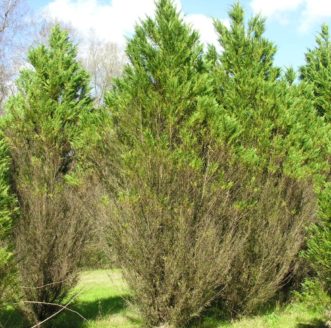Problems With Leyland Cypress
go.ncsu.edu/readext?851033
en Español / em Português
El inglés es el idioma de control de esta página. En la medida en que haya algún conflicto entre la traducción al inglés y la traducción, el inglés prevalece.
Al hacer clic en el enlace de traducción se activa un servicio de traducción gratuito para convertir la página al español. Al igual que con cualquier traducción por Internet, la conversión no es sensible al contexto y puede que no traduzca el texto en su significado original. NC State Extension no garantiza la exactitud del texto traducido. Por favor, tenga en cuenta que algunas aplicaciones y/o servicios pueden no funcionar como se espera cuando se traducen.
Português
Inglês é o idioma de controle desta página. Na medida que haja algum conflito entre o texto original em Inglês e a tradução, o Inglês prevalece.
Ao clicar no link de tradução, um serviço gratuito de tradução será ativado para converter a página para o Português. Como em qualquer tradução pela internet, a conversão não é sensivel ao contexto e pode não ocorrer a tradução para o significado orginal. O serviço de Extensão da Carolina do Norte (NC State Extension) não garante a exatidão do texto traduzido. Por favor, observe que algumas funções ou serviços podem não funcionar como esperado após a tradução.
English
English is the controlling language of this page. To the extent there is any conflict between the English text and the translation, English controls.
Clicking on the translation link activates a free translation service to convert the page to Spanish. As with any Internet translation, the conversion is not context-sensitive and may not translate the text to its original meaning. NC State Extension does not guarantee the accuracy of the translated text. Please note that some applications and/or services may not function as expected when translated.
Collapse ▲This article was written by Gail Griffin, Extension Master Gardener Volunteer with North Carolina Cooperative Extension in Lee County.
To get an idea of how many diseases commonly affect Leyland cypress, take a look at the episode of The Andy Griffith Show titled “Barney’s First Car”. After the once over at Wally’s Filling Station, the car needed “plugs, points, bearings, valves, rings, starter switch, ignition wires, water pump, fuel pump, oil pump…”, well, you get the picture. If you have had no issues with Leyland cypress, consider yourself fortunate. Its popularity has led to overplanting the species to the point that diseases are taking a toll on the landscape.
Leyland cypress, X Cuprocyparis leylandii, is a large, extremely fast growing evergreen that has the potential to grow one hundred feet tall and fifty feet wide. It is able to grow in a variety of soils and temperatures. It grows best in full sun in a well-drained location, spaced at least twelve to fifteen feet apart. Two main types of fungus affect the root system. Phytophthora root rot is found in poorly drained soils and usually affects younger trees. Plants may become stunted with sparse foliage that turns yellow, purple or tan. Sometimes cankers or lesions are evident at the soil line. Armillaria root rot results from deteriorating woody materials like tree stumps that have been left beneath the soil. It spreads to newly planted root systems and eventually, the rest of the plant, causing decayed areas on roots and bark. Symptoms include stunted growth, dieback of stems and branches and gradual or sudden death. Mushrooms may be present at the base. Pathogens of both types of fungus can remain in the soil even after the plant is removed. Poorly drained soils can spread the disease to plants nearby.
Three additional types of fungus affect portions of the plant above ground. Seiridium canker can be identified by dark oval lesions on stems and branches. Multiple cankers can form causing dieback. Needles will easily fall by running a

hand along the affected branch. It can spread by open wounds from lawn equipment or pruning tools. It can also be spread by overwatering. In Botryosphaeria dieback, needles don’t readily fall when handled but branches will turn yellow to brown. Cankers will girdle a stem and kill the stem beyond the canker. Passalora needle blight usually occurs during summer months and generally affects one year old growth. It causes needle browning and eventual drop from near the trunk spreading toward branch tips. It will spread upward over time until the only green is on the upper tips.
The decline of Leyland cypress has been as a result of monoculture problems meaning the overuse of a single plant species or cultivar. Plants placed too close together will only hasten the spread of these diseases. Control after these pathogens have reached the plant whether by air, by water or underneath the soil may be futile. Removal of infected branches and stems require disinfecting of tools in between cuts to avoid further spread. If the whole plant has to be removed, do not put another Leyland cypress in its place. Alternatives include Arizona cypress, Japanese cedar and Green Giant Arborvitae. The use of mixed screens is another solution. It involves planting multiple species in small clusters of three or five, or alternate layers to help control the spread of disease from one plant to another. For more information, go to hgic.clemson.edu/factsheet/leyland-cypress-diseases-insects-related-pests/
Other problems with Leyland cypress involve pests including bagworms, spider mites and scale. Also, a cypress weevil may be on the horizon. The list may continue to grow, only time will tell. For now we can only make better choices in replacing them should it become necessary. In case you need a reminder, “…clutch, clutch bearings, clutch plate…”
Gail Griffin is an Extension Master Gardener Volunteer with North Carolina Cooperative Extension in Lee County.




